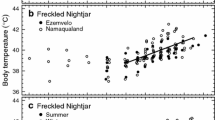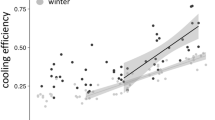Summary
Evaporative water loss (EWL), oxygen concumption \(\dot V_{O_2 } \), and body temperature (Tb) of Anna's Hummingbirds (Calypte anna; ca. 4.5g) were measured at combinations of ambient temperature (Ta) and water vapor density (ϱva) ranging from 20 to 37 °C and 2 to 27 g·m-3, respectively. The EWL decreased linearly with increasing ϱva at all temperatures. The slopes of least squares regression lines relating EWL to ϱva at different temperatures were not significantly different and averaged-0.50 mg H2O·m-3·g-2·h-1 (range:-0.39 to-0.61). Increased ϱva restricted EWL in C. anna more than has been reported for other endotherms in dry air. The percent of metabolic heat production dissipated by evaporation (\((\dot H_e /\dot H_m )\)) was lower than that of other birds in dry air, but higher than that for other birds at high humidity when Ta 33 °C. When Ta>33 °C the effect of humidity on \((\dot H_e /\dot H_m )\) was similar to that in other birds. Calypte anna might become slightly hyperthermic at Ta>37 °C, which could augment heat transfer by increasing the Tb-Ta gradient. Body temperature for C. anna in this study was 43 °C (intramuscular) at Tas between 25 and 35 °C, which is above average for birds. It is estimated that field EWL is less than 30% of daily water loss in C. anna under mild temperature conditions (<35 °C).
Similar content being viewed by others
Abbreviations
- BMR:
-
basal metabolic rate
- EWL:
-
evaporative water loss
- \(\dot H_e \) :
-
percent of metabolic heat production dissipated by evaporation
- \(\dot H_e \) :
-
ambient water vapor density
- \(\dot H_m \) :
-
body surface water vapor density
- RMR:
-
resting metabolic rate
- Ta :
-
ambient-temperature
- Tb :
-
body temperature
- Td :
-
dew-point temperature
- TNZ:
-
thermoneutral zone
- Ts :
-
body surface temperature
- \(\dot V_{co_{_2 } } \) :
-
carbon dioxide production
- \(\dot V_{O_2 } \) :
-
oxygen consumption
References
Aschoff J (1981) Thermal conductance in mammals and birds: its dependence on body size and circadian phase. Comp Biochem and Physiol 69A:611–619
Aschoff J, Pohl H (1970) Der Ruheumsatz von Vögeln als Funktion der Tageszeit und der Körpergröße. J Ornith 111:38–47
Bartholomew GA, Dawson WR (1953) Respiratory water loss in some birds of the southwestern United States. Physiol Zool 26:162–166
Bartholomew GA, Howell TR, Cade TJ (1957) Torpidity in the white-throated swift, Anna hummingbird, and poor-will. Condor 59:145–155
Bartholomew GA, Lighton JRB (1986) Oxygen consumption during hover-feeding in free-ranging Anna hummingbirds. J Exp Biol 123:191–199
Bartholomew GA, Vleck CM, Bucher TL (1983) Energy metabolism and nocturnal hypothermia in two tropical passerine frugivores, Manacus vitellinus and Pipra mentalis. Physiol Zool 56:370–379
Bernstein MH (1971) Cutaneous and respiratory evaporation in the painted quail, Excalfactoria chinensis, during ontogeny of thermoregulation. Comp Biochem Physiol 38A:611–617
Bernstein MH, Hudson DM, Sterans JM, Hoyt RW (1977) Measurement of evaporative water loss in small animals by dewpoint hygrometry. J Appl Physiol: Resp Environ Exercise Physiol 43:382–385
Brice AT, Grau CR (1989) Hummingbird nutrition: development of a purified diet for long-term maintenance. Zoo Biology 8:223–237
Calder WA (1979) On the temperature-dependency of optimal nectar concentrations for birds. J Theor Biol 78:185–196
Calder WA, Hiebert SM (1983) Nectar feeding, diuresis, and electrolyte replacement of hummingbirds. Physiol Zool 56:325–334
Calder WA, King JR (1974) Thermal and caloric relations of birds. In: Farner DS, King JR (eds) Avian biology, vol IV. Academic Press, New York, pp. 259–413
Campbell GS (1977) An introduction to environmental biophysics. Springer, New York Berlin Heidelberg
Carpenter FL (1974) Torpor in an Andean hummingbird: its ecological significance. Science 183:454–457
Chew RM (1955) The skin and respiratory water losses of Peromyscus maniculatus sonoriensis. Ecology 36:463–467
Chew RM (1965) Water metabolism of mammals. In: Mayer WV, Van Gelder RG (eds) Physiological mammalogy, vol II Academic Press, New York, pp. 43–178
Christian DP (1978) Effects of humidity and body size on evaporative water loss in three desert rodents. Comp Biochem Physiol 60A:425–430
Dawson WR (1982) Evaporative losses of water by birds. Comp Biochem Physiol 71A:495–509
Edwards RM, Haines H (1978) Effects of ambient water vapor pressure and temperature on evaporative water loss in Peromyscus maniculatus and Mus musculus. J Comp Physiol 128:177–184
Evans GC (1939) Ecological studies of rain forest of southern Nigeria: II. The atmospheric environmental conditions. J Ecol 27:436–482
Hainsworth FR, Wolf LL (1970) Regulation of oxygen consumption and body temperature during torpor in a hummingbird Eulampis jugularis. Science 168:368–369
Hiebert SM (1990) Energy costs and temporal organization of torpor in the rufous hummingbird (Selasphorus rufus). Physiol Zool 63:1082–1097
Hill RW (1972) Determination of oxygen consumption by use of the paramagnetic oxygen analyzer. J Appl Physiol 33:261–263
Janzen DH (1976) The microclimate differences between a deciduous forest and adjacent riparian forest in Guanacaste Province, Costa Rica. Brenesia 8:29–33
Lasiewski RC (1963) Oxygen consumption of torpid, resting active, and flying hummingbirds. Physiol Zool 36:122–140
Lasiewski RC (1964) Body temperatures, heart and breathing rate, and evaporative water loss in hummingbirds. Physiol Zool 37:212–233
Lasiewski RC, Acosta AL, Bernstein MH (1966a) Evaporative water loss in birds: I. Characteristics of the open-flow method of determination, and their relation to estimates of thermoregulatory ability. Comp Biochem Physiol 19:445–457
Lasiewski RC, Acosta AL, Bersntein MH (1966b) Evaporative water loss in birds: II. A modified method for determination by direct weighing. Comp Biochem Physiol 19:459–470
Lasiewski RC, Lasiewski RJ (1967) Physiological responses of the blue-throated and Rivoli's hummingbirds. Auk 84:34–48
Lasiewski RC, Weathers WW, Bernstein MH (1967) Physiological responses of the giant hummingbird, Patagona gigas. Comp Biochem Physiol 23:797–813
Lee P, Schmidt-Nielsen K (1971) Respiratory and cutaneous evaporation in the zebra finch: effect on water balance. Am J Physiol 220:1598–1605
Levy A (1964) The accuracy of the bubble meter method for gas flow measuremets. J Scient Instrum 41:449–453
Lighton JRB (1985) Minimum cost of transport and ventilatory patterns in three African beetles. Physiol Zool 58:390–399
List RJ (ed) (1951) Smithsonian meteorological tables, 6th edn. Smithson Misc Collect 114:1–527
Monteith JL (1973) Principles of environmental physics. Edward Arnold, London
Morrison P (1962) Modification of body temperature by activity in Brazilian hummingbirds. Condor 64:315–323
Nagy KA, Peterson CC (1988) Scaling of water flux rate in animals Univ Calif Publ Zool 120:1–172
Pearson OP (1950) The metabolism of hummingbirds. Condor 52:145–152
Pearson OP (1954) The daily energy requirements of a wild Anna hummingbird. Condor 56:317–322
Powers DR (1987) Effects of variation in food quality on the breeding territoriality of the male Anna's hummingbird. Condor 89:103–111
Powers DR (1989) Energy and water relations of hummingbirds. PhD thesis, University of California, Davis, 148
Powers DR, Nagy KA (1988) Field metabolic rate and food consumption by free-living Anna's hummingbirds. Physiol Zool 61:500–506
Proctor JW, Studier EH (1970) Effects of ambient temperature and water vapor pressure on evaporative water loss in Myotis lucifugus. J Mammal 51:799–804
Raab JL, Schmidt-Nielsen K (1972) Effect of running on water balance of the kangaroo rat. Am J Physiol 222:1230–1235
Richards SA (1976) Evaporative water loss in domestic fowls and its partition in relation to ambient temperature. J Agric Sci 87:527–532
Schuchmann K-L, Schmidt-Marloh D (1979a) Metabolic and thermal responses to heat and cold in streamertail hummingbirds (Trochilus polytmus and Trochilus scitulus, Trochilidae). Biotropica 11:123–126
Schuchmann K-L, Schmidt-Marloh D (1979b) Temperature regulation in non-torpid hummingbirds. Ibis 121:354–356
Skadhauge E (1981) Osmoregulation in birds. (Zoophysiology, vol. 12) Springer, New York Berlin Heidelberg
Stiles FG (1971) Time, energy, and territoriality of the Anna hummingbird (Calypte anna). Science 173:818–820
Stiles FG (1973) Food supply and the annual cycle of the Anna hummingbird. Univ Calif Publ Zool 97:1–109
Stiles FG (1982) Aggressive and courtship displays of the male Anna's hummingbird. Condor 84:208–223
Stiles FG, Wolf LL (1970) Hummingbird territoriality at a tropical flowering tree. Auk 87:467–491
Walsberg GE, King JR (1978) The relationship of the external surface area of birds to skin surface area and body mass. J Exp Biol 76:185–189
Weathers WW (1977) Temperature regulation in the dusky munia, Lonchura fuscans (Cassin) (Estrildidae). Austr Zool 25:193–199
Weathers WW (1979) Climatic adaptation in avian standard metabolic rate. Oecologia 42:81–89
Weathers WW (1981) Physiological thermoregulation in heatstressed birds: consequences of body size. Physiol Zool 54:345–361
Weathers WW (1986) Thermal significance of courtship display in the blue-black grassquit (Volatinia jacarina). Nat Geogr Res 2:291–301
Weathers WW, Shapiro CJ, Astheimer LB (1980) Metabolic responses of Cassin's finches (Carpodacus cassinii) to temperature. Comp Biochem Physiol 65A:235–238
Webster MD, Campbell GS, King JR (1985) Cutaneous resistance to water-vapor diffusion in pigeons and the role of the plumage. Physiol Zool 58:58–70
Webster MD, King JR (1987) Temperature and humidity dynamics of cutaneous and respiratory evaporation in pigeons, Columba livia. J Comp Physiol B 157:253–260
Welch WR (1980) Evaporative water loss from endotherms in thermally and hygrically complex environments: an empirical approach for interspecific comparisons. J Comp Physiol 139:135–143
Wetmore A (1921) A study of the body temperature of birds. Smithson Misc Collect 72 (12):1–52
Zar JH (1974) Biostatistical analysis. Prentice Hall, New Jersey
Author information
Authors and Affiliations
Rights and permissions
About this article
Cite this article
Powers, D.R. Effect of temperature and humidity on evaporative water loss in Anna's hummingbird (Calypte anna). J Comp Physiol B 162, 74–84 (1992). https://doi.org/10.1007/BF00257939
Accepted:
Issue Date:
DOI: https://doi.org/10.1007/BF00257939




